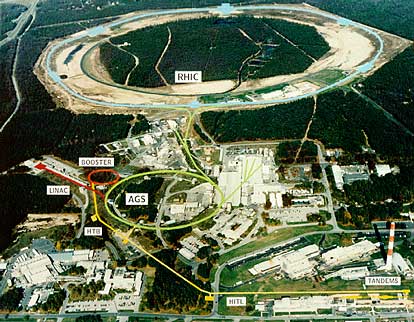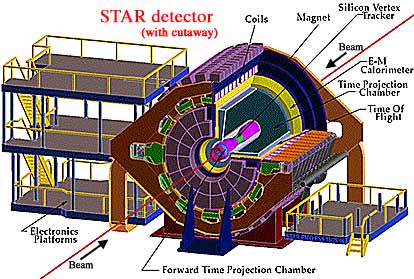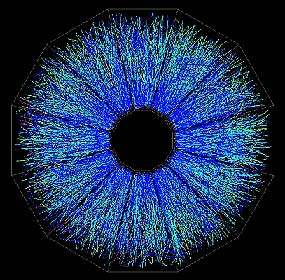![]()
![]()
We have previously investigated pressure and temperature as measures of materials in our surroundings. By pushing these to extremes we are able to investigate the nature of matter that must have existed less than a millionth of a second after the Big Bang. Those conditions are currently rare, perhaps only in the cores of neutron stars. Recently it has become possible to very briefly create and study those conditions by colliding heavy atoms together (in large machines such as the Relativistic Heavy Ion Collider at Brookhaven, New York, shown in areal view below). Evidence suggests that the materials briefly created under the extreme pressure and temperature rapidly come to equilibrium and can be investigated by what flies apart from the collision.
 While much of this science involves topics to be studied in more detail later, we can begin to investigate and understand quark matter. Humans have been considering and investigating the nature of matter for several millennia (as will be studied in Unit VI). We now understand that the wide variety of matter we observe with our senses is made of groupings of only a few elementary particles. One of the basic kinds of particles is called quarks. Quarks normally only exist in temporary pairs (which we call mesons), or more permanent groups of three, (particles we call baryons). (There is a little evidence for other groupings but that evidence is dubious.) Clusters of baryons are formed into nuclei, held together by mesons and surrounded by electrons, (a representative of another group of basic particles called leptons). These packages we call atoms. The atoms in turn are combined to form molecules and crystals which we perceive with our senses as solids, liquids, and gases. The current theory about matter predicts that at extreme temperature and pressure a new state of matter, consisting of interacting quarks, antiquarks, and gluons which bond them together. In this investigation we begin to gather information about properties of this quark matter.
While much of this science involves topics to be studied in more detail later, we can begin to investigate and understand quark matter. Humans have been considering and investigating the nature of matter for several millennia (as will be studied in Unit VI). We now understand that the wide variety of matter we observe with our senses is made of groupings of only a few elementary particles. One of the basic kinds of particles is called quarks. Quarks normally only exist in temporary pairs (which we call mesons), or more permanent groups of three, (particles we call baryons). (There is a little evidence for other groupings but that evidence is dubious.) Clusters of baryons are formed into nuclei, held together by mesons and surrounded by electrons, (a representative of another group of basic particles called leptons). These packages we call atoms. The atoms in turn are combined to form molecules and crystals which we perceive with our senses as solids, liquids, and gases. The current theory about matter predicts that at extreme temperature and pressure a new state of matter, consisting of interacting quarks, antiquarks, and gluons which bond them together. In this investigation we begin to gather information about properties of this quark matter.
When a couple of the larger atoms such as gold are crashed together at extreme energy in machines called heavy ion colliders, much of the energy of the collision can be converted to matter as suggested by Albert Einstein with his famous equation, E = mc2 (to be studied more in Unit V.) A large amount of quark matter is created in the collision. This rapidly comes to equilibrium under the high energy equivalent to a trillion degrees temperature and high density equivalent to the high pressure inside a neutron star. Much of the new matter flies apart and can be detected and tracked in large devices which surround the site of the collision. By studying what flies out, and as importantly, what was expected but doesn't fly out, the behavior of quark matter at these extreme conditions can be studied.
 This experiment involves vaporizing a few (~109) isolated atoms of gold and removing the gold's electrons leaving highly positively charged gold ions. Electrical fields increase the ions' speed and magnetic fields guide and focus them along an otherwise evacuated tube. The areal photograph (above) shows the pathway, actually 12 feet underground, followed by the gold ions. The gold ions start near the bottom of the photograph and move along the yellow pathway, being accelerated by the tandem van de Graaff, receive more acceleration in the red booster ring, still more acceleration in the green AGS (Alternating Gradient Synchrotron) ring, then receive final acceleration in the 4 kilometer circumference blue RHIC (Relativistic Heavy Ion Collider) to 99.995% of the speed of light at energies of 100 GeV. Some gold ions circulate clockwise through one RHIC ring for hours while others circulate counter-clockwise in a neighboring ring (see photo). The paths of the gold ions cross at several locations resulting in about a thousand nuclear collisions per second. For comparisons with collisions with much lighter atoms, hydrogen are ionized and initially accelerated by the linear accelerator (LINAC).
This experiment involves vaporizing a few (~109) isolated atoms of gold and removing the gold's electrons leaving highly positively charged gold ions. Electrical fields increase the ions' speed and magnetic fields guide and focus them along an otherwise evacuated tube. The areal photograph (above) shows the pathway, actually 12 feet underground, followed by the gold ions. The gold ions start near the bottom of the photograph and move along the yellow pathway, being accelerated by the tandem van de Graaff, receive more acceleration in the red booster ring, still more acceleration in the green AGS (Alternating Gradient Synchrotron) ring, then receive final acceleration in the 4 kilometer circumference blue RHIC (Relativistic Heavy Ion Collider) to 99.995% of the speed of light at energies of 100 GeV. Some gold ions circulate clockwise through one RHIC ring for hours while others circulate counter-clockwise in a neighboring ring (see photo). The paths of the gold ions cross at several locations resulting in about a thousand nuclear collisions per second. For comparisons with collisions with much lighter atoms, hydrogen are ionized and initially accelerated by the linear accelerator (LINAC).
 The STAR is one of four detectors located at intersection points along the circular paths. Generally each is built in layers with inner layers detecting the shortest lived particles and massive outer layers designed to stop much of the remaining particles to determine the energy. Some particles continue through the detector undetected and their presence must be surmised by missing momentum and energy. The locations of passing particles are detected electronically and their paths constructed and portrayed by computers.
The STAR is one of four detectors located at intersection points along the circular paths. Generally each is built in layers with inner layers detecting the shortest lived particles and massive outer layers designed to stop much of the remaining particles to determine the energy. Some particles continue through the detector undetected and their presence must be surmised by missing momentum and energy. The locations of passing particles are detected electronically and their paths constructed and portrayed by computers.
 A single pair of quarks from the incoming nuclei strike each other directly with such force that they scatter at large angles, with high momentum transfer. Such events, which even at the highest energies are relatively rare in collisions between small ions, give rise to narrowly collimated sprays of quark matter called jets. The direction of the jet emerging from a hard-scattering collision is presumed to be the direction of the initially scattered particle. As the primary particle proceeds, the energy it carries generates a large shower of other particles which constitute the the jet. From the particle types, numbers, and momenta in the jet, the kinematic and quantum properties of the initially scattered particle can be determined. In collision between large atoms such as gold, as many as 5000 tracks of electrically charged particles are recorded for a single collision. Additional uncharged particles do not leave tracks. The pattern of a typical collision between two gold ions is shown by the computer reconstructed image at left. With such a huge number of tracks, computers are helpful for determining patterns. In this investigation we shall look at the results obtained from the relatively rare direct head-on
A single pair of quarks from the incoming nuclei strike each other directly with such force that they scatter at large angles, with high momentum transfer. Such events, which even at the highest energies are relatively rare in collisions between small ions, give rise to narrowly collimated sprays of quark matter called jets. The direction of the jet emerging from a hard-scattering collision is presumed to be the direction of the initially scattered particle. As the primary particle proceeds, the energy it carries generates a large shower of other particles which constitute the the jet. From the particle types, numbers, and momenta in the jet, the kinematic and quantum properties of the initially scattered particle can be determined. In collision between large atoms such as gold, as many as 5000 tracks of electrically charged particles are recorded for a single collision. Additional uncharged particles do not leave tracks. The pattern of a typical collision between two gold ions is shown by the computer reconstructed image at left. With such a huge number of tracks, computers are helpful for determining patterns. In this investigation we shall look at the results obtained from the relatively rare direct head-on central
hits which create jets. It is believed that such a collision creates some unstable heavier quarks. These decay into a spray of products which share the emerging direction of the original quark matter. The detector thus records an occasional narrow jet of particles carrying a large burst of energy in a common direction.
| Angle [radians] | d+Au FTPC-Au 0-20% | d+Au Minimum Bias | p+p Minimum Bias | Pedestal subtracted d+Au FTPC-Au 0-20% | Pedestal subtracted p+p Minimum Bias |
| -1.23 | 0.0560+/-0.0063 | 0.0413+/-0.0034 | 0.0080+/-0.0040 | 0.0045+/-0.0063 | 0.0005+/-0.0040 |
| -1.07 | 0.0489+/-0.0059 | 0.0370+/-0.0032 | 0.0101+/-0.0045 | -0.0027+/-0.0059 | 0.0025+/-0.0045 |
| -0.92 | 0.0539+/-0.0062 | 0.0410+/-0.0034 | 0.0161+/-0.0057 | 0.0024+/-0.0062 | 0.0085+/-0.0057 |
| -0.77 | 0.0489+/-0.0059 | 0.0368+/-0.0032 | 0.0060+/-0.0035 | -0.0027+/-0.0059 | -0.0015+/-0.0035 |
| -0.61 | 0.0654+/-0.0069 | 0.0496+/-0.0038 | 0.0241+/-0.0070 | 0.0139+/-0.0069 | 0.0166+/-0.0070 |
| -0.46 | 0.0776+/-0.0075 | 0.0550+/-0.0040 | 0.0241+/-0.0070 | 0.0261+/-0.0075 | 0.0166+/-0.0070 |
| -0.31 | 0.0891+/-0.0080 | 0.0809+/-0.0048 | 0.0483+/-0.0099 | 0.0376+/-0.0080 | 0.0407+/-0.0099 |
| -0.15 | 0.1516+/-0.0104 | 0.1504+/-0.0065 | 0.1046+/-0.0145 | 0.1001+/-0.0104 | 0.0970+/-0.0145 |
| 0 | 0.1782+/-0.0113 | 0.1866+/-0.0073 | 0.2031+/-0.0202 | 0.1267+/-0.0113 | 0.1956+/-0.0202 |
| 0.15 | 0.1444+/-0.0102 | 0.1408+/-0.0063 | 0.1488+/-0.0173 | 0.0929+/-0.0102 | 0.1413+/-0.0173 |
| 0.31 | 0.0920+/-0.0081 | 0.0792+/-0.0048 | 0.0664+/-0.0116 | 0.0404+/-0.0081 | 0.0588+/-0.0116 |
| 0.46 | 0.0654+/-0.0069 | 0.0561+/-0.0040 | 0.0080+/-0.0040 | 0.0139+/-0.0069 | 0.0005+/-0.0040 |
| 0.61 | 0.0589+/-0.0065 | 0.0459+/-0.0036 | 0.0121+/-0.0049 | 0.0074+/-0.0065 | 0.0045+/-0.0049 |
| 0.77 | 0.0582+/-0.0065 | 0.0399+/-0.0034 | 0.0101+/-0.0045 | 0.0067+/-0.0065 | 0.0025+/-0.0045 |
| 0.92 | 0.0496+/-0.0060 | 0.0405+/-0.0034 | 0.0121+/-0.0049 | -0.0019+/-0.0060 | 0.0045+/-0.0049 |
| 1.07 | 0.0539+/-0.0062 | 0.0373+/-0.0033 | 0.0080+/-0.0040 | 0.0024+/-0.0062 | 0.0005+/-0.0040 |
| 1.23 | 0.0417+/-0.0055 | 0.0311+/-0.0030 | 0.0080+/-0.0040 | -0.0098+/-0.0055 | 0.0005+/-0.0040 |
| 1.38 | 0.0503+/-0.0060 | 0.0390+/-0.0033 | 0.0040+/-0.0028 | -0.0012+/-0.0060 | -0.0035+/-0.0028 |
| 1.53 | 0.0611+/-0.0066 | 0.0484+/-0.0037 | 0.0121+/-0.0049 | 0.0096+/-0.0066 | 0.0045+/-0.0049 |
| 1.69 | 0.0575+/-0.0064 | 0.0419+/-0.0035 | 0.0020+/-0.0020 | 0.0060+/-0.0064 | -0.0055+/-0.0020 |
| 1.84 | 0.0596+/-0.0065 | 0.0453+/-0.0036 | 0.0141+/-0.0053 | 0.0081+/-0.0065 | 0.0065+/-0.0053 |
| 1.99 | 0.0445+/-0.0057 | 0.0388+/-0.0033 | 0.0181+/-0.0060 | -0.0070+/-0.0057 | 0.0106+/-0.0060 |
| 2.15 | 0.0589+/-0.0065 | 0.0499+/-0.0038 | 0.0181+/-0.0060 | 0.0074+/-0.0065 | 0.0106+/-0.0060 |
| 2.3 | 0.0797+/-0.0076 | 0.0601+/-0.0041 | 0.0241+/-0.0070 | 0.0282+/-0.0076 | 0.0166+/-0.0070 |
| 2.45 | 0.0848+/-0.0078 | 0.0675+/-0.0044 | 0.0442+/-0.0094 | 0.0333+/-0.0078 | 0.0367+/-0.0094 |
| 2.61 | 0.1027+/-0.0086 | 0.0886+/-0.0050 | 0.0543+/-0.0105 | 0.0512+/-0.0086 | 0.0468+/-0.0105 |
| 2.76 | 0.1035+/-0.0086 | 0.0843+/-0.0049 | 0.0744+/-0.0122 | 0.0519+/-0.0086 | 0.0669+/-0.0122 |
| 2.91 | 0.1257+/-0.0095 | 0.1160+/-0.0057 | 0.0865+/-0.0132 | 0.0742+/-0.0095 | 0.0789+/-0.0132 |
| 3.06 | 0.1437+/-0.0102 | 0.1265+/-0.0060 | 0.1287+/-0.0161 | 0.0922+/-0.0102 | 0.1212+/-0.0161 |
| 3.22 | 0.1236+/-0.0094 | 0.1222+/-0.0059 | 0.1488+/-0.0173 | 0.0721+/-0.0094 | 0.1413+/-0.0173 |
| 3.37 | 0.1250+/-0.0095 | 0.1140+/-0.0057 | 0.0905+/-0.0135 | 0.0735+/-0.0095 | 0.0830+/-0.0135 |
| 3.52 | 0.0912+/-0.0081 | 0.0909+/-0.0051 | 0.0784+/-0.0126 | 0.0397+/-0.0081 | 0.0709+/-0.0126 |
| 3.68 | 0.0891+/-0.0080 | 0.0784+/-0.0047 | 0.0523+/-0.0103 | 0.0376+/-0.0080 | 0.0447+/-0.0103 |
| 3.83 | 0.0855+/-0.0078 | 0.0655+/-0.0043 | 0.0362+/-0.0085 | 0.0340+/-0.0078 | 0.0287+/-0.0085 |
| 3.98 | 0.0862+/-0.0079 | 0.0658+/-0.0043 | 0.0382+/-0.0088 | 0.0347+/-0.0079 | 0.0307+/-0.0088 |
| 4.14 | 0.0589+/-0.0065 | 0.0487+/-0.0037 | 0.0181+/-0.0060 | 0.0074+/-0.0065 | 0.0106+/-0.0060 |
| 4.29 | 0.0582+/-0.0065 | 0.0413+/-0.0034 | 0.0141+/-0.0053 | 0.0067+/-0.0065 | 0.0065+/-0.0053 |
| 4.44 | 0.0553+/-0.0063 | 0.0467+/-0.0036 | 0.0201+/-0.0064 | 0.0038+/-0.0063 | 0.0126+/-0.0064 |
| 4.6 | 0.0517+/-0.0061 | 0.0379+/-0.0033 | 0.0060+/-0.0035 | 0.0002+/-0.0061 | -0.0015+/-0.0035 |
| 4.75 | 0.0503+/-0.0060 | 0.0368+/-0.0032 | 0.0161+/-0.0057 | -0.0012+/-0.0060 | 0.0085+/-0.0057 |
| 4.9 | 0.0417+/-0.0055 | 0.0311+/-0.0030 | 0.0060+/-0.0035 | -0.0098+/-0.0055 | -0.0015+/-0.0035 |
quark matter. Sometimes one of the jets is formed near the edge of the quark matter causing the jet in the opposite direction to pass though the bulk of the quark matter.
| Angle [radians] | Pedestal/Elliptic Flow subtracted Au+Au Central |
| -1.2 | -0.0111+/-0.0100 |
| -0.9 | -0.0043+/-0.0101 |
| -0.6 | 0.0197+/-0.0102 |
| -0.3 | 0.0534+/-0.0103 |
| 0 | 0.1769+/-0.0108 |
| 0.3 | 0.0839+/-0.0104 |
| 0.6 | 0.0134+/-0.0102 |
| 0.9 | -0.0052+/-0.0101 |
| 1.2 | -0.0060+/-0.0100 |
| 1.5 | -0.0092+/-0.0100 |
| 1.8 | 0.0097+/-0.0101 |
| 2.09 | 0.0171+/-0.0101 |
| 2.39 | -0.0002+/-0.0101 |
| 2.69 | -0.0026+/-0.0101 |
| 2.99 | 0.0044+/-0.0102 |
| 3.29 | -0.0071+/-0.0101 |
| 3.59 | 0.0148+/-0.0102 |
| 3.89 | 0.0028+/-0.0101 |
| 4.19 | 0.0233+/-0.0102 |
| 4.49 | 0.0078+/-0.0101 |
| 4.79 | 0.0231+/-0.0101 |
The finding of the strength of the second opposite jet peak tells a lot about the nature of this high temperature, high pressure quark matter. Any significant reduction in the intensity of the jet travelling through the quark matter would require energy transfer equivalent to super friction involving major interactions between the constituents of the quark matter.
In the head-on central collisions a large fraction of the kinetic energy is converted into a high-temperature plasma of quarks, antiquarks, and gluons. This immediately begins to expand and cool, passing down through the critical temperature at which they condense into a system of mesons, baryons, and antibaryons--perhaps in thermal equilibrium. As the expansion continues, the system eventually reaches its freeze-out
density, at which the particles no longer interact with each other. The particles emerging from the freeze-out volume are the ones that stream into the detectors. But theorists propose that in between is formed a universal form of matter currently called color glass condensate (CGC). It has properties similar to glasses, that is, very slow evolution compared to the natural time scales of constituent interactions.
![]()
to next Experiment
to ie-Physics menu
to site menu